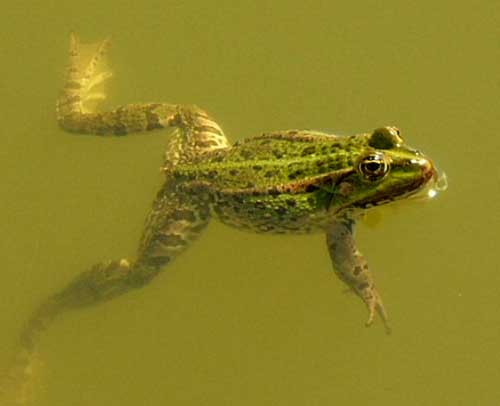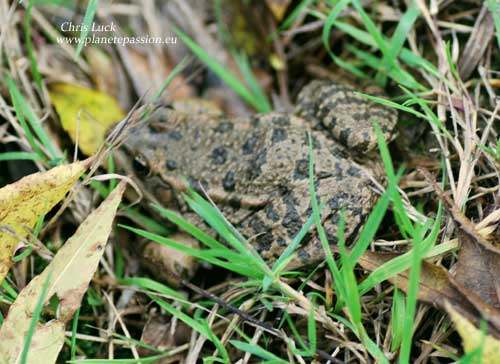Marsh Frog
Pelophylax ridibundus, formally Rana ridibundus
Grenouille Rieuse
(Alt.English name - Lake Frog)
Marsh frogs are the largest native frog in France and can reach up to 13 cm in length; with specimens that exceed 10 cm being almost exclusively females. Colouration and marking are variable, body and flanks can be olive brown, greenish yellow, dark green and on occasion bright green or blue, frequently the back is darker than the flanks or the head. Upper body skin can be quite smooth or warty and is marked with brown or green spots. Undersides of their legs are cream or grey and their belly is marbled or streaked with grey or black. Their pupil is horizontal oval and the iris is a more or less uniform yellow / bronze often marked with black.
They are currently to be found in many regions of France and in the interest of accuracy with possible continuing introductions and expansions in natural range no attempt is made to be specific. They occupie a large range of aquatic habitats, canals, large lakes, rivers, open ponds, woodland ponds, drainage ditches and peat marshlands but are rarely found at altitudes over 800 metres. They are often the only amphibian to be found occupying waters where there are a large number of fish. They tolerate various forms of pollution such as the outflows from large car parks that are high in hydro carbons. In parts of France their presence is largely a result of accidental or deliberate release, two major factors have been their culinary use for frog legs and it is also a species that is used in medical and scientific research, in many instances there have been importations of Pelophylax kurtmuelleri, (also a Marsh frog), from south eastern Europe. It is a species that is robust and colonises at an alarming rate often using rivers and streams to expand its range. The "native" marsh frog, Pelophylax ridibundus, has been present since the retreat of the Würm glacification some 10,000 years before present.
Diet is varied, insects of all types, baby snakes, frogs and newts, lizards and even small mammals.
Reproduction takes place from late spring when the female releases packets of eggs, usually about 10, each one containing about 1000 eggs which the male fertilises, these hatch after 5 to 10 days and metamorphosis is completed in summer.
Hibernation takes place either in or in close proximity to the water.
This species also breeds with Pelophylax lessonae, creating Pelophylax kl. Esculentus. and with Pelophylax perezi, creating Pelophylax kl. Grafi.
It is likely that with the introductions that have taken place that this frog has a negative impact on other species and it is forbidden to move or introduce them elsewhere and I would encourage people to adhere to this. This is especially important in the case of imported specimens of Grenouille Rieuse from south eastern Europe, Pelophylax kurtmuelleri, (wasRana kurtmuelleri), and the Near East, Pelophylax bedriagae, (was Rana bedriagae). Visually there is little or no difference between the three species of Marsh frog.





